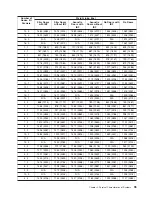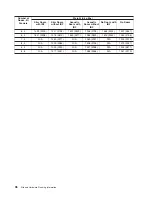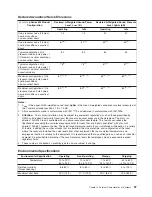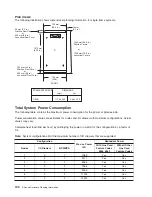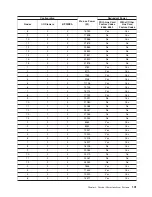
7039
Eserver
pSeries 655
The
Eserver
pSeries 655 system consists of multiple components, as summarized in the following table.
Model
Description
Minimum per
System
Maximum per
System
7040-W42
Base Frame (Redundant power supplies as
feature codes)
1
1
FC6076
Slimline Front Door
2
1
1
1
1
FC6119
Acoustic Front Door
2
1
1
1
1
FC6078
Slimline Rear Door
2
1
1
1
1
FC6079
Acoustical Rear Door
2
1
1
1
1
FC6200 or FC6201
Optional Integrated Battery Feature (IBF)
0
6
7039-651
Server Node (up to 8 processors, 4 GB to 32
GB memory)
1
16
7315-C01
Hardware Management Console (HMC)
0
2
7040-61D
IO Subsystem (20 PCI cards maximum, 16
DASD maximum)
0
5
Notes:
1. Either slimline doors or acoustical doors must be selected by the customer during the order process.
2. Door options determine which doors are included with your
Eserver
Eserver
pSeries 655 Doors and Covers
Covers are an integral part of the
Eserver
pSeries 655 and are
required
for product safety and EMC
compliance. The following rear door options are available for the
Eserver
pSeries 655:
v
″
Enhanced Acoustical
″
Cover Option
This feature provides a low-noise option for customers or sites with stringent acoustical requirements
and where a minimal system footprint is not critical. The Acoustical cover option consists of a special
front and rear doors which are approximately 250 mm (10 in.) deep and contain acoustical treatment
that lowers the noise level of the machine by approximately 7 dB (0.7 B) compared to the Slimline
doors. This reduction in noise emission levels means that the noise level of a single
Eserver
pSeries
655 system with Slimline covers is about the same as the noise level of five
Eserver
pSeries 655
systems with acoustical covers.
v
″
Slimline
″
Cover Option
This feature provides a smaller-footprint and lower-cost option for customers or sites where space is
more critical than acoustical noise levels. The Slimline cover option consists of a front door, which is
approximately 100 mm (4 in) deep, and a rear door, which is approximately 50 mm (2 in) deep. No
acoustical treatment is available for this option.
Note:
Moving the System to the Installation Site
The customer should determine the path that must be taken to move the system from the delivery location
to the installation site. The customer should verify that the height of all doorways, elevators, and so on are
sufficient to allow moving the system to the installation site. The customer should also verify that the
weight limitations of elevators, ramps, floors, floor tiles, and so on are sufficient to allow moving the
Chapter 2. Physical Characteristics of Systems
87
Summary of Contents for 7012 397
Page 1: ...RS 6000 and Eserver pSeries Site and Hardware Planning Information SA38 0508 20...
Page 2: ......
Page 3: ...RS 6000 and Eserver pSeries Site and Hardware Planning Information SA38 0508 20...
Page 11: ...Appendix Notices 385 Index 387 Contents ix...
Page 12: ...x Site and Hardware Planning Information...
Page 16: ...xiv Site and Hardware Planning Information...
Page 18: ...xvi Site and Hardware Planning Information...
Page 26: ...8 Site and Hardware Planning Information...
Page 238: ...220 Site and Hardware Planning Information...
Page 246: ...228 Site and Hardware Planning Information...
Page 284: ...266 Site and Hardware Planning Information...
Page 296: ...278 Site and Hardware Planning Information...
Page 366: ...348 Site and Hardware Planning Information...
Page 372: ...Async Adapter Cable Planning Chart 354 Site and Hardware Planning Information...
Page 377: ...Standard I O Cable Planning Chart Chapter 12 Cable Planning 359...
Page 380: ...Cable Planning Chart Other Adapters 362 Site and Hardware Planning Information...
Page 384: ...366 Site and Hardware Planning Information...
Page 402: ...384 Site and Hardware Planning Information...
Page 404: ...386 Site and Hardware Planning Information...
Page 413: ......
Page 414: ...Printed in USA SA38 0508 20...
Page 415: ...Spine information RS 6000 and Eserver pSeries Site and Hardware Planning Information...























